 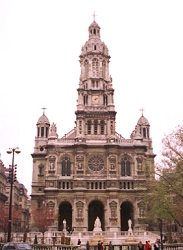 Paris
|
| The Organ | 19th-Century Disposition 20th-Century Disposition | Photographs |
The ChurchThe Church of the Holy Trinity is relatively new among the great churches of Paris, having been built during the middle of the nineteenth century and carrying a completion date of 1867. The exterior of the building is rather impressive, and the slight elevation of the façade above the level of the plaza in front of the church improves its visual effect. Like many other Second Empire buildings, however, it is rather weighty in appearance, in spite of the ornate decorations that are found on almost every available surface. The tower, one of the tallest in Paris, gives the appearance of having been built up of different smaller ones stacked up together, so that each layer appears to to be almost an afterthought added above the one below it.
|
| Top of Page | 19th-Century Disposition | 20th-Century Disposition | Photographs |
The OrganThe organ was built for the church by Aristide Cavaillé-Coll and inaugurated in 1869, only two years after the completion of the building. The organist was M. Charles-Alexis Chauvet, who was succeeded upon his death in 1871 by Alexandre Guilmant. Guilmant continued to play the organ until 1901, and most of his published organ music was conceived while he was titulaire of this great instrument. A brief note reminding him not to play a sortie after Vespers on the first Sunday of the month bears his signature and can still be found in a small room to the south of the organ gallery.176
|
| Top of Page | The Organ 20th-Century Disposition | Photographs |
Nineteenth-Century DispositionThe first proposal Cavaillé-Coll submitted for the Trinité organ was for a three-manual instrument of 36 speaking stops. As is often the case, some changes were made in the original proposal, and the instrument as finally built had 46 speaking stops, disposed as you see here:179 |
| Grand Orgue C-g''' Manual I |
Positif C-g''' Manual II |
Récit expressif C-g''' Manual III |
Pédale C-f' |
|||||||||||
|---|---|---|---|---|---|---|---|---|---|---|---|---|---|---|
| Montre | 16 | Flûte | 16 | Flûte | 8 | Bourdon | 32 | |||||||
| Bourdon | 16 | Bourdon | 8 | Bourdon | 8 | Contrebasse | 16 | |||||||
| Montre | 8 | Salicional | 8 | Gambe | 8 | Sous-basse | 16 | |||||||
| Bourdon | 8 | Unda maris | 8 | Voix céleste | 8 | Flûte | 8 | |||||||
| Flûte | 8 | Flûte | 4 | Flûte | 4 | Bourdon | 8 | |||||||
| Gambe | 8 | Prestant | 4 | Octavin | 2 | Violoncelle | 8 | |||||||
| Prestant | 4 | Doublette | 2 | Voix humaine | 8 | Flûte | 4 | |||||||
| Flûte octaviante | 4 | Piccolo | 1 | Hautbois | 8 | Bombarde | 16 | |||||||
| Doublette | 2 | Cornet V | Trompette | 8 | Trompette | 8 | ||||||||
| Cornet V | Basson | 16 | Clairon | 4 | Clairon | 4 | ||||||||
| Plein jeu V | Clarinette | 8 | ||||||||||||
| Bombarde | 16 | Trompette | 8 | |||||||||||
| Trompette | 8 | |||||||||||||
| Clairon | 4 | |||||||||||||
| Pédales de combinaisons: | ||||||||||||||
| Appel des jeux Pédale Tirasse Grand Orgue Tirasse Positif Tirasse Récit Copula Positif sur Grand Orgue Copula Récit sur Grand Orgue Copula Récit sur Positif Grand Orgue sur machine |
Octaves graves du Grand Orgue Trémolo du Récit Anches Pédale Anches Grand Orgue Anches Positif Anches Récit Expression du Récit |
|||||||||||||
| Early in the history of the organ, perhaps as early as some work done on the organ by Cavaillé-Coll in 1872, the 2' Doublette was replaced by a 2 2/3' Quinte, which remains on the organ today. With that single alteration, the stoplist above is the one that the organ had in the nineteenth century, during most of Guilmant's tenure at La Trinité.
As you look at the disposition above, you should notice several things which are commonly found in nineteenth-century French organs:178
|
| Top of Page | The Organ 19th-Century Disposition | Photographs |
Twentieth-Century DispositionThe organ of La Trinité was modified and enlarged several times in the twentieth century, initially in 1901, when some tonal changes were made in the course of work being done by Merklin. The first major change came in 1934-5, however, when these stops were added by "la maison Pleyel-Cavaillé-Coll", working at the request of Olivier Messiaen, who had recently become the titulaire:
 The bottom row lists the Pédales de Combinaison, which now included several additions to the original list.177 Physically, these resembled the "hitch-down" couplers you may have seen on some mechanical-action instruments. Reading them all from left to right we see them in this order, both in a realization of the French abbreviations and in an English equivalent.
|
| Grand Orgue C-g''' |
Positif C-g''' |
Récit C-g''' |
Pédale C-f' |
|||||||||||
|---|---|---|---|---|---|---|---|---|---|---|---|---|---|---|
| Montre | 16 | Quintaton | 16 | Bourdon | 16 | Soubasse | 32 | |||||||
| Bourdon | 16 | Principal | 8 | Flûte | 8 | Contrebasse | 16 | |||||||
| Montre | 8 | Flûte harmonique | 8 | Bourdon | 8 | Soubasse | 16 | |||||||
| Flûte harmonique | 8 | *Cor de Nuit | 8 | Gambe | 8 | Flûte | 8 | |||||||
| Bourdon | 8 | Salicional | 8 | Voix céleste | 8 | Bourdon | 8 | |||||||
| Gambe | 8 | Unda maris | 8 | Flûte douce | 4 | Violoncelle | 8 | |||||||
| Prestant | 4 | Prestant | 4 | Nazard | 2 2/3 | Flûte | 4 | |||||||
| Flûte | 4 | *Flûte douce | 4 | Octavin | 2 | Plein jeu IV | ||||||||
| Quinte | 2 2/3 | *Nazard | 2 2/3 | Tierce | 1 3/5 | Bombarde | 16 | |||||||
| Doublette | 2 | *Flageolet | 2 | Cymbale III | Trompette | 8 | ||||||||
| Cornet V | Doublette | 2 | Bombarde | 16 | Clairon | 4 | ||||||||
| Plein jeu V | *Tierce | 1 3/5 | Trompette | 8 | ||||||||||
| Cymbale IV | *Piccolo | 1 | Hautbois | 8 | ||||||||||
| Bombarde | 16 | Cornet V | Voix humaine | 8 | ||||||||||
| Trompette | 8 | Fourniture | Clairon | 4 | ||||||||||
| Clairon | 4 | Basson | 16 | |||||||||||
| Trompette | 8 | |||||||||||||
| *Clarinette | 8 | |||||||||||||
| Clairon | 4 | |||||||||||||
| Accessories: | ||||||||||||||
| Tirasses G, P, R en 8' & 4' Accouplements P-G, R-G, R-P (en 8') Accouplements G-G, P-P, R-R en 16' & 4' Annulations 8' Ped, G, P, R Annulations anches Ped, G, P, R Trémolo R |
Thumb reversibles for all unison couplers Toe reversibles for all couplers, annulations 8' et anches Six general combinations, duplication thumb & toe Ajuster, Annulateur [set & cancel - thumb only] Expression P, R (balanced pedals) Crescendo (roller, 12 steps) |
|||||||||||||
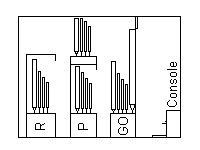 One important aspect of the current disposition that cannot be seen in this list is the layout of the chests. Immediately behind the façade, the Grand Orgue is placed on a chest arranged in the Traditional French manner: The larger pipes are to the ends, divided and the Cornet V is mounted above the main chest level. The Pédale is divided on either side of the Grand Orgue. The Positif is behind the Grand Orgue, and as you can see in the diagram to the left, there are two levels to that division. Those stops marked with an asterisk in the stoplist above are placed in an enclosure - - a "swell box," if you wish. The other Positif stops are on a separate chest mounted on top of the Positif enclosure. The Récit, all of whose stops are enclosed, is behind the Positif.180 One important aspect of the current disposition that cannot be seen in this list is the layout of the chests. Immediately behind the façade, the Grand Orgue is placed on a chest arranged in the Traditional French manner: The larger pipes are to the ends, divided and the Cornet V is mounted above the main chest level. The Pédale is divided on either side of the Grand Orgue. The Positif is behind the Grand Orgue, and as you can see in the diagram to the left, there are two levels to that division. Those stops marked with an asterisk in the stoplist above are placed in an enclosure - - a "swell box," if you wish. The other Positif stops are on a separate chest mounted on top of the Positif enclosure. The Récit, all of whose stops are enclosed, is behind the Positif.180
|
| Top of Page | The Organ 19th-Century Disposition | 20th-Century Disposition |
Enlarged ImagesIf you would like to see enlargments of some of the photographs on this page, as well as photographs of some of the pipes of La Trinité's organ, you can choose from the selections below. You will have to use the "back" button on your browser to return to this page. The extremely large size of some of these images means that loading them will take an unduly long time if you are viewing these pages through a modem connection.
|
© 1999 James H. Cook
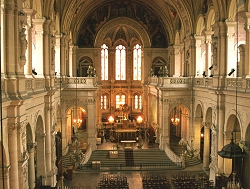
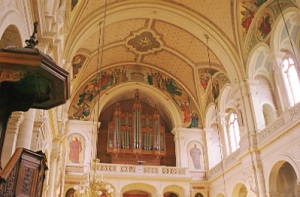 The motif of saints and angels that is above the altar is repeated above the organ gallery at the west end of the church, as you can see in the photograph to the left. The colorful painting adds decorative elements to the flat surfaces of walls as well as to the entire ceiling. Although it was for many years stained and darkened inside, the church was cleaned and restored in the 1990's, and now its windows and the colorful painting combine to provide a warm glow to the interior.
The motif of saints and angels that is above the altar is repeated above the organ gallery at the west end of the church, as you can see in the photograph to the left. The colorful painting adds decorative elements to the flat surfaces of walls as well as to the entire ceiling. Although it was for many years stained and darkened inside, the church was cleaned and restored in the 1990's, and now its windows and the colorful painting combine to provide a warm glow to the interior.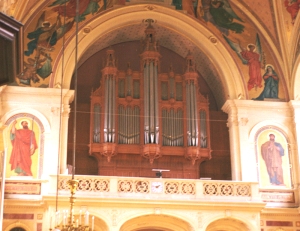 The façade of the case, with the pipes of the 16' Montre of the Grand Orgue displayed in three towers and several flats, has changed very little since its installation. An interesting element in this organ, the façade was designed in the nineteenth century for this specific instrument, whereas many of Cavaillé-Coll's organs were built into existing cases. You should notice these characteristics when you look at the photograph:
The façade of the case, with the pipes of the 16' Montre of the Grand Orgue displayed in three towers and several flats, has changed very little since its installation. An interesting element in this organ, the façade was designed in the nineteenth century for this specific instrument, whereas many of Cavaillé-Coll's organs were built into existing cases. You should notice these characteristics when you look at the photograph: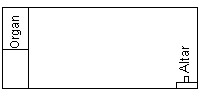 The second diagram shows the church in simplified cross-section, and you can see how far the Récit is from the front of the gallery and the rest of the church. This placement of divisions, in which the Récit must speak through and around the Positif enclosure, then past the Grand Orgue and console, is an important part of the organ's disposition. Even with its reeds and mixtures on, the sound is never blatant, never agressive, always speaking from a distance, even to the player seated at the console.
The second diagram shows the church in simplified cross-section, and you can see how far the Récit is from the front of the gallery and the rest of the church. This placement of divisions, in which the Récit must speak through and around the Positif enclosure, then past the Grand Orgue and console, is an important part of the organ's disposition. Even with its reeds and mixtures on, the sound is never blatant, never agressive, always speaking from a distance, even to the player seated at the console.